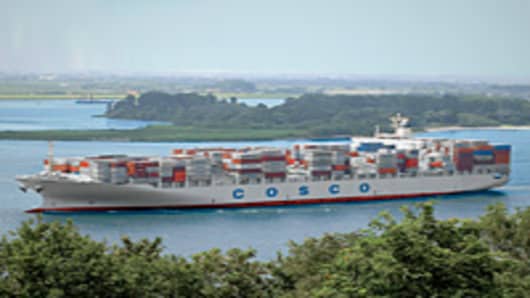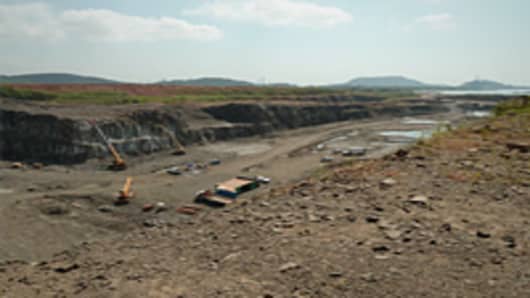Nearly 100 years ago, the Panama Canal hosted its first passage, a watershed event that has influenced the landscape of shipping and transportation ever since. Now, the canal is due to rattle international trade once more, potentially reshaping the way sea-borne shipping and rail lines tackle business in the world’s largest consumer nation.
A massive, $5 billion-plus expansion of the canal looks on track to wrap in 2014, just in time for the waterway's centennial. The expansion will allow the passage of larger, so-called “Post-Panamax” vessels that can haul roughly double the cargo of ships that currently fit the canal.
Importantly, the expansion will also give ship lines around the world, particularly those with massive container ships, yet another route for moving goods to the United States.
For corporations shipping goods to the U.S., the often cheaper option of crossing through the canal could prove too good to pass up.
“It is more expensive for the container line ship to move a box from Los Angeles to Chicago by rail then it is for the line to move the box from Shanghai to Los Angeles,” said Tom Finkbiner, senior chairman of the board of the Intermodal Transportation Institute and a former intermodal executive at Norfolk Southern.
This means the expansion project is high on the radar of a wide range of players in U.S. shipping and transportation, from the country’s busiest port—the Port of Los Angeles—to the rail companies and intermodal players that support the ports and the constant flow in and out of them.
Fewer containers moving from Asia through the Port of LA, for example, will likely impact a railway like Warren Buffet's Burlington Northern Santa Fe , though the company downplays that possibility.
"We don't think at this point it will have a huge impact," BNSF executive vice president and chief marketing officer John Lanigan said in a recent interview with CNBC.com. "It won't add to our business because of the opening," he added. "It will potentially detract from our business."
Burlington Northern serves all container ports on the West Coast and the Texas Gulf Coast. Close ties with ports like Los Angeles and Long Beach, a pair which accommodated more than 40 percent of all twenty-foot container units (TEUs) imported into the United States in 2009, will support the railway post-expansion, Lanigan said.
“Obviously our interest is in freights…that don’t come through the Panama Canal,” he said. “We’re ready to compete from movements that want to go all-water.”
“All-water” routes call directly to the U.S. East Coast, skipping West Coast ports and the cross-country intermodal system composed of trucks and railways like BNSF. Fraught with oversupply, container lines around the world have been offering dirt-cheap rates. This has led to an interesting conundrum for shippers weighing the costs of moving goods to critical centers like Chicago and New York.
Christian Wetherbee, a senior transportation analyst for Citigroup, notes that rates for container ships have fallen “significantly,” while “rail rates have gone nothing but up.”
Speed
Parties like BNSF’s Lanigan, however, dispute any true cost advantage of shipping through the canal, while also noting the West’s prime advantage: speed.
“It’s absolutely quicker to go to the West Coast,” Lanigan said, adding that it’s also “indisputed that freight gets to the inland faster.”
Estimates of shipping times vary across the industry; Finkbiner estimates that a haul shipped on the Pacific Ocean and railed to Chicago would take roughly 14-15 days, while the same haul routed through the Port of New York would take closer to 25-28 days.
At the Port of Los Angeles, senior director of communications Arley Baker said he is confident the speed to market offered by the West Coast ports and intermodal system will remain a “top priority” for shippers.
“We can hit middle America days sooner than an all-water route would,” Baker said.
"a market they’ve never had before"
Yet Urs Dur, shipping and logistics analyst for Lazard Capital Markets, said he believes shippers will swap time for money when considering the all-water option the expanded canal will provide.
“They will do so because it will be cheaper and frankly because it’s faster,” Dur said. “I suppose you can probably beat it to Tampa but not by much.”
Battleground
Any sense of regionalism could be near its end as a number of the rails move towards establishing and expanding operations in the Southeast, a region that is particularly well-suited for first-call ports.
“Frankly, it would serve a line well that would go through the canal to stop in the Southeast and offload the Midwest freight,” said Finkbiner. “It gives the Southeast ports a market they’ve never had before.”
Virginia-based Norfolk Southern , which last year opened the Heartland Corridor network out of the Port of Virginia while also expanding a Jacksonville facility, says it is placing heavy focus on terminal capacity in its Southeast approach.
“We’ve designed our network around making it work either way,” said Jeff Heller, group vice president of international intermodal for Norfolk Southern. “East Coast/West Coast is someone else’s decision.”
Burlington Northern, meanwhile, opened a new intermodal facility in Memphis last year, a “gateway” city that has become a “very important distribution center,” according to Lanigan.
Scarce Funds
Looming large in the future of the Southeast ports, however, is a challenge facing ports around the country, on every coast—the desperate need for significant infrastructure investments.
These projects, which range from dredging waterways to installing larger cranes, are heavily dependent on federal funding and many currently risk going unfunded in time for the expanded canal.
Today, the Port of Virginia is the only East Coast port that can accommodate the larger fully-loaded Post-Panamax ships, a likely reason for the origination of Norfolk Southern’s Heartland Corridor out of the Port. (Charleston, currently dredged to 45 feet, can handle the Post-Panamax ships, but not when they are fully loaded.)
In Georgia, Governor Nathan Deal has loudly appealed the Obama administration for federal funding to deepen its Savannah port. The governor has said the state needs $105 million in federal funds for the project, however Obama’s recent budget proposal allotted it just $600,000 in engineering and design funds.
Funding and other uncertainties suggest it will be a high-speed race to the finish for U.S. transportation players looking for a piece of the Post-Panamax pie.
“Everything is kind of linked politically,” Citigroup’s Wetherbee said. “There are questions if they [East Coast ports] will be ready."
Clarification: A fuller quote from BNSF executive vice president and chief marketing officer John Lanigan has been added to the story to emphasize that the company doesn't expect the canal opening to have a big impact on their business.



